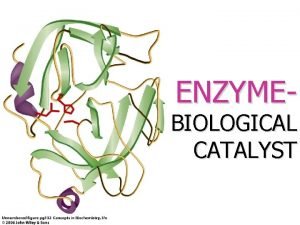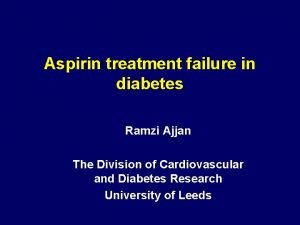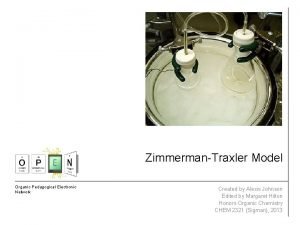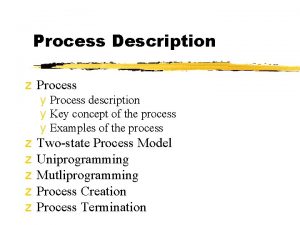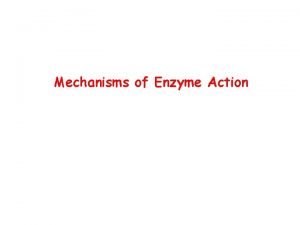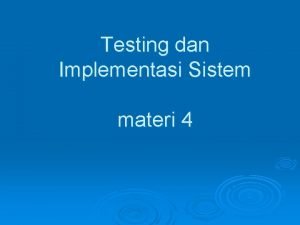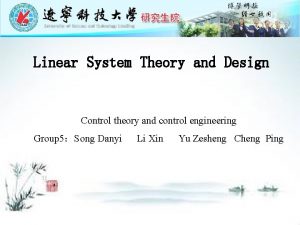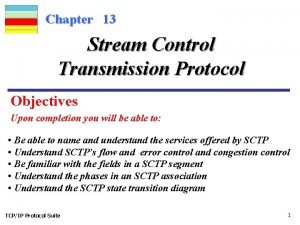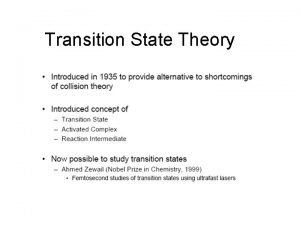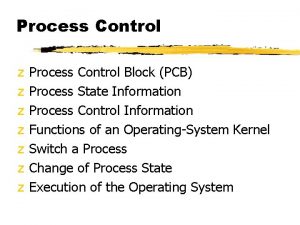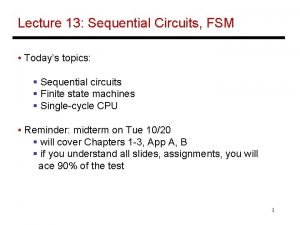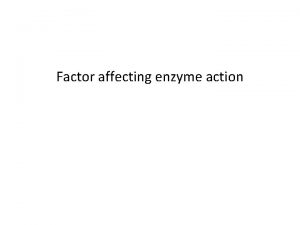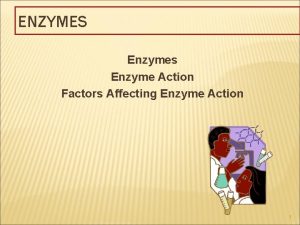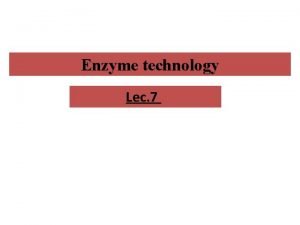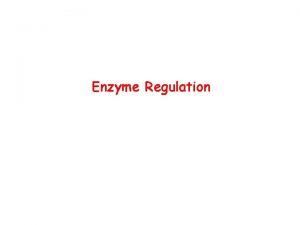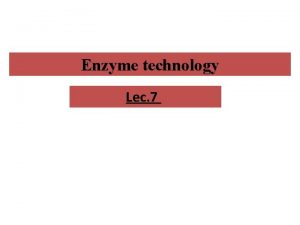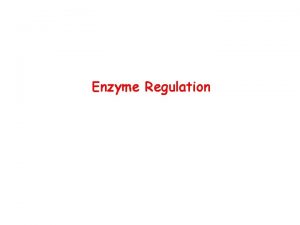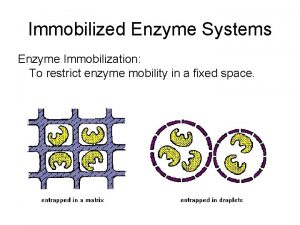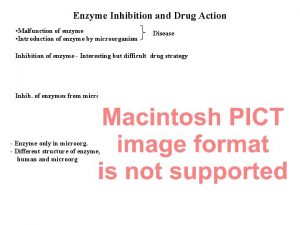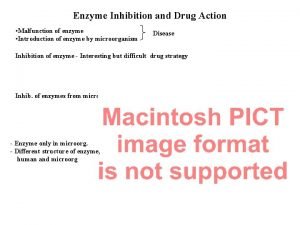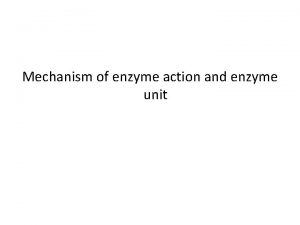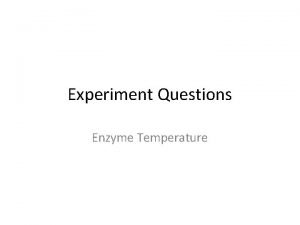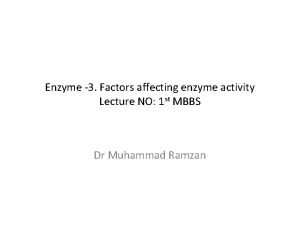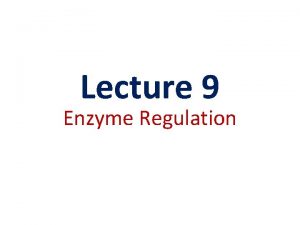Lecture 8 Mechanisms of Enzyme Action Transition State

















- Slides: 17

Lecture 8 Mechanisms of Enzyme Action

Transition State & Intermediate • Rate of reaction depends on the frequency at which reactants collide and form the Transition State (TS). - Reactants must be in the correct orientation and collide with sufficient energy to form transition state. • The energy require to reach transition state from ground state is called Activation Energy. - Activation energy barrier must be exceeded for reaction to proceed. - Lower activation energy barrier result in more stable TS. - The higher the TS, the more likely the reaction will proceed.

Transition State & Intermediate • Transition State is an unstable high-energy intermediate. • Bonds are in the process of being formed and broken in TS. - Short lived (10– 14 to 10 -13 secs). • In reactions with intermediates, 2 transition states are involved. - Intermediates are stable. - Formation of intermediate during reaction is the slowest step.

Transition State & Intermediate • Enzyme binding of substrates decrease activation energy by increasing the initial ground state (brings reactants together). • When TS binds to the active site, the activation energy is further lowered, resulting in a faster reaction.

Transition State & Intermediate Why is energy required to reach transition state lower in the active site? It is a magic pocket (1) Stabilizes transition + Co. E (1) (4) - (3) (2) Expels water (3) Reactive groups (4) Positions coenzymes

Enzymatic Catalysis • The first step in an enzymatic reaction is the formation of a noncovalent enzyme-substrate complex, ES.

Chemical Modes of Enzymatic Catalysis • In biological reaction, formation of the ES complex places reactants close to reactive amino acid residues in the enzyme active sites. • These reactive amino acid residues in the enzyme active sites are often ionizable side chains.

Common Types of Enzymatic Mechanisms • There are many common types of enzymatic mechanisms: 1. Substitutions reactions. 2. Bond cleavage reactions. 3. Redox reactions. 4. Acid base catalysis. 5. Covalent catalysis.

Common Types of Enzymatic Mechanisms 1. Substitutions reactions. • Nucleophillic Substitution. Nucleophillic = e- rich Electrophillic = e- poor • Direct Substitution. transition state

Common Types of Enzymatic Mechanisms 2. Bond cleavage reactions. • Heterolytic vs homolytic cleavage. • Carbanion formation (retains both e-) • Carbocation formation (lose both e-) • Free radical formation (lose single e-)

Common Types of Enzymatic Mechanisms 3. Oxidation reduction (Redox) Reactions. • Central to energy production. • Loose e- = oxidation (LEO). - Oxidations = removal of hydrogen or addition of oxygen or removal of e-. - If one atom/molecule is oxidized, another must be reduced (reducing agent donates e- to oxidizing agent). • Gain e- = reduction (GER). • In biological systems reducing agent is usually a co-factor (NADH of NADPH).

Common Types of Enzymatic Mechanisms 4. Acid base catalysis. • • Accelerates reactions by catalytic transfer of a proton. Involves amino acid residues that can accept a proton. Can remove proton from –OH, -NH or -CH. Creates a strong nucleophillic reactant.

Common Types of Enzymatic Mechanisms 5. Covalent catalysis. • 20% of all enzymes employ covalent catalysis. • A group from a substrate binds covalently to enzyme. • The intermediate enzyme substrate complex (A-X) then donates the group (X) to a second. • i. e. Protein Kinases.

The Serine Proteases • A group of protease that involve a serine component in catalysis. - i. e. Trypsin, chymotrypsin, elastase, thrombin, subtilisin, plasmin. - All these serine proteases are structurally similar: Chymotrypsin Trypsin Elastase

The Serine Proteases

The Serine Proteases • Part of a "catalytic triad" of Ser, His, Asp. • Substrate specificity are determined by binding pocket.

The Serine Proteases Mechanism of Chymotrypsin-catalyzed of a peptide model (Page 188 -189)
 Biological catalyst examples
Biological catalyst examples Zczc state graph
Zczc state graph Mechanism of action of asprin
Mechanism of action of asprin Aspirin mechanism of action
Aspirin mechanism of action 01:640:244 lecture notes - lecture 15: plat, idah, farad
01:640:244 lecture notes - lecture 15: plat, idah, farad Zimmerman traxler modell
Zimmerman traxler modell Process y
Process y Difference between transition state and intermediate
Difference between transition state and intermediate State transition testing adalah
State transition testing adalah State space analysis
State space analysis Mesi state transition diagram
Mesi state transition diagram What is state transition matrix
What is state transition matrix Linear system
Linear system 13stream
13stream Energy reaction coordinate diagram
Energy reaction coordinate diagram Unix process state transition diagram
Unix process state transition diagram State transition table
State transition table Seven state process transition diagram
Seven state process transition diagram
